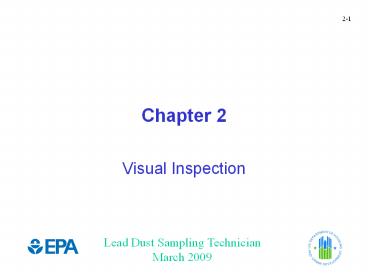Visual Inspection - PowerPoint PPT Presentation
Title:
Visual Inspection
Description:
Chapter 2 Visual Inspection Visual Inspection Visual Inspection HUD LSHR Visual Inspection HUD LSHR Review (cont.) Visual Inspection Visual Inspection ... – PowerPoint PPT presentation
Number of Views:2155
Avg rating:3.0/5.0
Title: Visual Inspection
1
Chapter 2
- Visual Inspection
2
Objectives
- Learn what a visual inspection is
- Learn the steps for performing a visual
inspection under both EPAs and HUDs regulations - Learn when to look for deteriorated paint,
visible dust or debris, and paint chips - Record results on a visual inspection form
3
Visual Inspection
- Under both EPAs and HUDs rules, visual
inspection is the first step in the clearance
process. - Under EPAs rule, the visual inspection is
designed to determine if the area is free of
visible dust and debris before lead dust
clearance testing can begin.
4
Visual Inspection (cont.)
- The visual inspection determines whether the
unit/work area (interior and exterior) is clear
of visible conditions that can result in exposure
to lead-based paint hazards - Chips or debris
- Visible dust
- In addition, HUDs rule requires identification
of deteriorated paint. - Required before dust sampling can begin
- Whole-unit clearance generally required
5
Visual Inspection EPA RRP Lead Dust Clearance
Testing
- At the conclusion of the renovation, the
certified renovator may have conducted a visual
inspection to look for paint chips, dust, and
debris. - The LDST must conduct a separate visual
inspection of the work area to ensure that the
area is ready for lead dust sampling. - If any paint chips, dust, or debris are found,
the renovation firm should re-clean these areas
before the dust sampling technician begins to
collect dust wipe samples.
6
Visual Inspection HUD LSHR
- Addresses entire unit unless worksite-only
clearance is allowed. - Do not perform lead dust clearance testing if
unit/work area does not pass visual inspection. - If deteriorated paint, dust, or debris is found,
it must be eliminated before dust testing may
begin. - See Attachment 2-A and 2-B
7
Visual Inspection HUD LSHR
- Inspect exterior area if
- Exterior painted surfaces have been disturbed by
renovation activity - Openings to exterior were not sealed during
interior work - Inspect ground and outdoor living areas close to
affected surfaces - Visible dust or debris must be removed
- Deteriorated paint must be eliminated
- Dust sampling is not performed for exterior work
8
Exterior Debris
9
Visual Inspection HUD LSHR
- Identify any paint that is not intact
- Chipping
- Peeling
- Chalking
- Cracking
- Holes, moisture, and friction damage
- Hairline cracks and nail holes are not considered
deteriorated paint.
10
Visual Inspection HUD LSHR
- Dust
- Dust you can see
- Debris
- Pieces of wood, bits of plaster, and various
other building pieces covered in paint - Paint chips
- Small pieces of paint
11
Visual Inspection HUD LSHR
Chipping Paint
12
Visual Inspection HUD LSHR
Holes in wall
13
Visual Inspection HUD LSHR
Deteriorated Paint
14
Visual Inspection HUD LSHR
Cracking Paint
15
Visual Inspection HUD LSHR
Moisture Damage
16
Visual Inspection HUD LSHR
Friction Damage
17
Visual Inspection HUD LSHR
- Be precise about locations.
- Write down results as you go.
- Write down other information, indicating source.
- See sample visual inspection form. (Attachment
2-B)
18
Review
- Visual inspection is the first step to clearance.
- EPAs visual inspection determines that the area
is free of dust and debris before dust clearance
testing can begin. - HUDs visual inspection also checks for
deteriorated paint and generally covers the
entire unit unless worksite-only clearance is
allowed.
19
Review (cont.)
- Visual inspection as part of clearance is the
responsibility of the dust sampling technician. - Be methodical in your visual inspection, and
record results.































